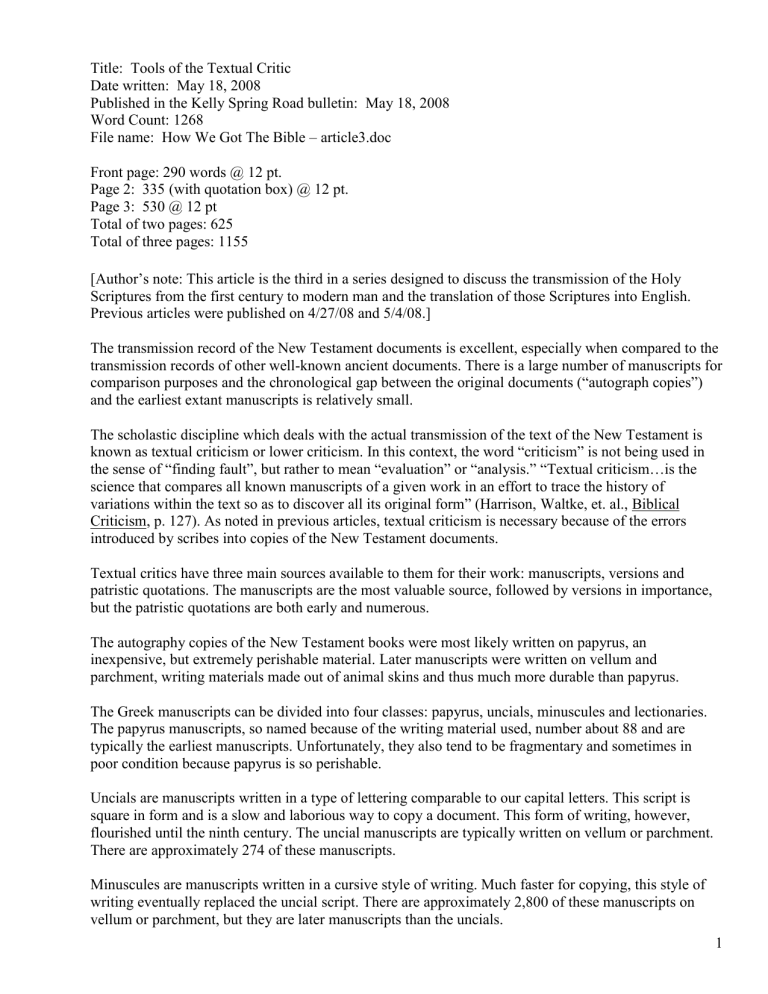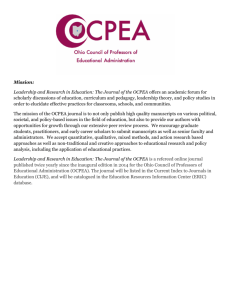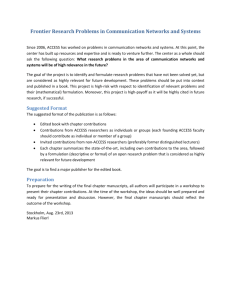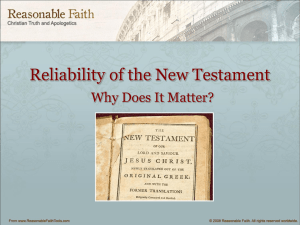3. Tools of The Textual Critic

Title: Tools of the Textual Critic
Date written: May 18, 2008
Published in the Kelly Spring Road bulletin: May 18, 2008
Word Count: 1268
File name: How We Got The Bible – article3.doc
Front page: 290 words @ 12 pt.
Page 2: 335 (with quotation box) @ 12 pt.
Page 3: 530 @ 12 pt
Total of two pages: 625
Total of three pages: 1155
[Author’s note: This article is the third in a series designed to discuss the transmission of the Holy
Scriptures from the first century to modern man and the translation of those Scriptures into English.
Previous articles were published on 4/27/08 and 5/4/08.]
The transmission record of the New Testament documents is excellent, especially when compared to the transmission records of other well-known ancient documents. There is a large number of manuscripts for comparison purposes and the chronological gap between the original documents (“autograph copies”) and the earliest extant manuscripts is relatively small.
The scholastic discipline which deals with the actual transmission of the text of the New Testament is known as textual criticism or lower criticism. In this context, the word “criticism” is not being used in the sense of “finding fault”, but rather to mean “evaluation” or “analysis.” “Textual criticism…is the science that compares all known manuscripts of a given work in an effort to trace the history of variations within the text so as to discover all its original form” (Harrison, Waltke, et. al., Biblical
Criticism, p. 127). As noted in previous articles, textual criticism is necessary because of the errors introduced by scribes into copies of the New Testament documents.
Textual critics have three main sources available to them for their work: manuscripts, versions and patristic quotations. The manuscripts are the most valuable source, followed by versions in importance, but the patristic quotations are both early and numerous.
The autography copies of the New Testament books were most likely written on papyrus, an inexpensive, but extremely perishable material. Later manuscripts were written on vellum and parchment, writing materials made out of animal skins and thus much more durable than papyrus.
The Greek manuscripts can be divided into four classes: papyrus, uncials, minuscules and lectionaries.
The papyrus manuscripts, so named because of the writing material used, number about 88 and are typically the earliest manuscripts. Unfortunately, they also tend to be fragmentary and sometimes in poor condition because papyrus is so perishable.
Uncials are manuscripts written in a type of lettering comparable to our capital letters. This script is square in form and is a slow and laborious way to copy a document. This form of writing, however, flourished until the ninth century. The uncial manuscripts are typically written on vellum or parchment.
There are approximately 274 of these manuscripts.
Minuscules are manuscripts written in a cursive style of writing. Much faster for copying, this style of writing eventually replaced the uncial script. There are approximately 2,800 of these manuscripts on vellum or parchment, but they are later manuscripts than the uncials.
1
Lectionaries are a special kind of manuscript designed for public reading of Scripture. Numbering more than 2,200, lectionaries employ both the uncial and the minuscule scripts. Although the lectionaries typically date from the sixth to twelfth centuries, they tend to be good manuscripts because they were copied for public church use.
There are several manuscripts of each class which stand out as singularly important. For instance, among the papyri, the John Rylands Fragment (p52 – its designation) is a very valuable witness. It is a small portion of the gospel of John. Its value is not in the reconstruction of the text (contains only five verses), but in the determination of the date of writing for the gospel. This manuscript, found in Egypt, has been dated at A.D. 117-138. At one time, liberal scholars dated the gospel of John in the third century (and thus not written by the apostle John), but this papyrus fragment will not permit such a late date and is, in fact, strong evidence for a first century date of authorship.
The Chester Beatty Papyri (p45, p46 & -47) are three codices (a manuscript in a book form rather than a scroll format is called a codex; codices is the plural) which together contain most of the New Testament.
They are dated at A.D. 250.
Another important witness to the text is the Bodmer Papyri (p66, p72 & p75). These early manuscripts
(A.D. 175 – 200+) contain Jude, 1 & 2 Peter, and the earliest known copy of Luke.
Among the uncials, several manuscripts stand out. Codex Vaticanus (designated “B”) is thought to be the oldest uncial and contains most of the New Testament with the exception of Hebrews 9:14-13:25, 1
& 2 Timothy, Titus and Revelation. It is dated at A.D. 325-350. Codex Sinaiticus (designated by the
Hebrew letter Aleph) is also considered to be an extremely important witness. It is dated at A.D. 340 and contains about half of the LXX (a Greek translation of the Old Testament) and the entire New
Testament.
Codex Alexandrinus (“A”) contains most of the Old Testament and the New Testament. It is dated at
A.D. 450. Codex Ephraemi Rescriptus (“C”) is a unique kind of manuscript. Dated at about A.D. 345, the biblical text was rubbed out and sermons of a church father by the name of Ephraem were copied onto the manuscript material! The original biblical text was restored by chemical means, providing a manuscript of the New Testament missing the books of 2 Thessalonians and 2 John.
The oldest known bilingual manuscript is the Codex Bezae (“D”) and is dated about A.D. 450-550. It contains the gospels, Acts and part of Third John, written in both Greek and Latin.
As already noted, another source for the textual critic is versions. Examples of early versions include the
Old Syriac (2 main manuscripts, evidently copied from a second century manuscript), the Syriac Peshitta
(New Testament from the fifth century with 350 manuscripts of this version) and the Latin Vulgate. The
Latin Vulgate, dated c. A.D. 384, was actually a revision of the Old Latin version (A.D. 200) and became THE version in the western half of the Roman empire; as a result, there are many copies of this version.
The value of the versions is that they give the textual critic valuable information concerning textual transmission and corruption. They are inferior to the manuscripts in importance because some features of the Greek language are lost in the translation to another language, making it difficult to reconstruct the original text behind the translation.
2
The third source for textual analysis is patristic quotations. The “apostolic fathers” were men who studied under the apostles or sat at the feet of others who studied under the apostles. It is estimated that there are approximately 32,000 quotations in the writings of these apostolic fathers by the turn of the fourth century. Although it should be noted that the apostolic fathers were not given to verbatim quotations, they quoted so extensively that it has been said that the New Testament could be reconstructed from these quotations except for eleven verses!
Textual critics have a vast amount of material to analyze and compare in order to determine what the original text is in cases of manuscript variations. Sir Frederic Kenyon wrote that “the Christian can take the whole Bible in his hand and say without fear or hesitation that he holds in it the true word of God, handed down without essential loss from generation to generation...The number of manuscripts of the
New Testament, of early translations from it, and of quotations from it in the oldest writers of the
Church, is so large that it is practically certain that the true reading of every doubtful passage is preserved in some one or other of these ancient authorities. This can be said of no other ancient book in the world.” (Our Bible and the Ancient Manuscripts, p. 55; quoted by Geisler and Nix, A General
Introduction to the Bible, p. 355)
3





